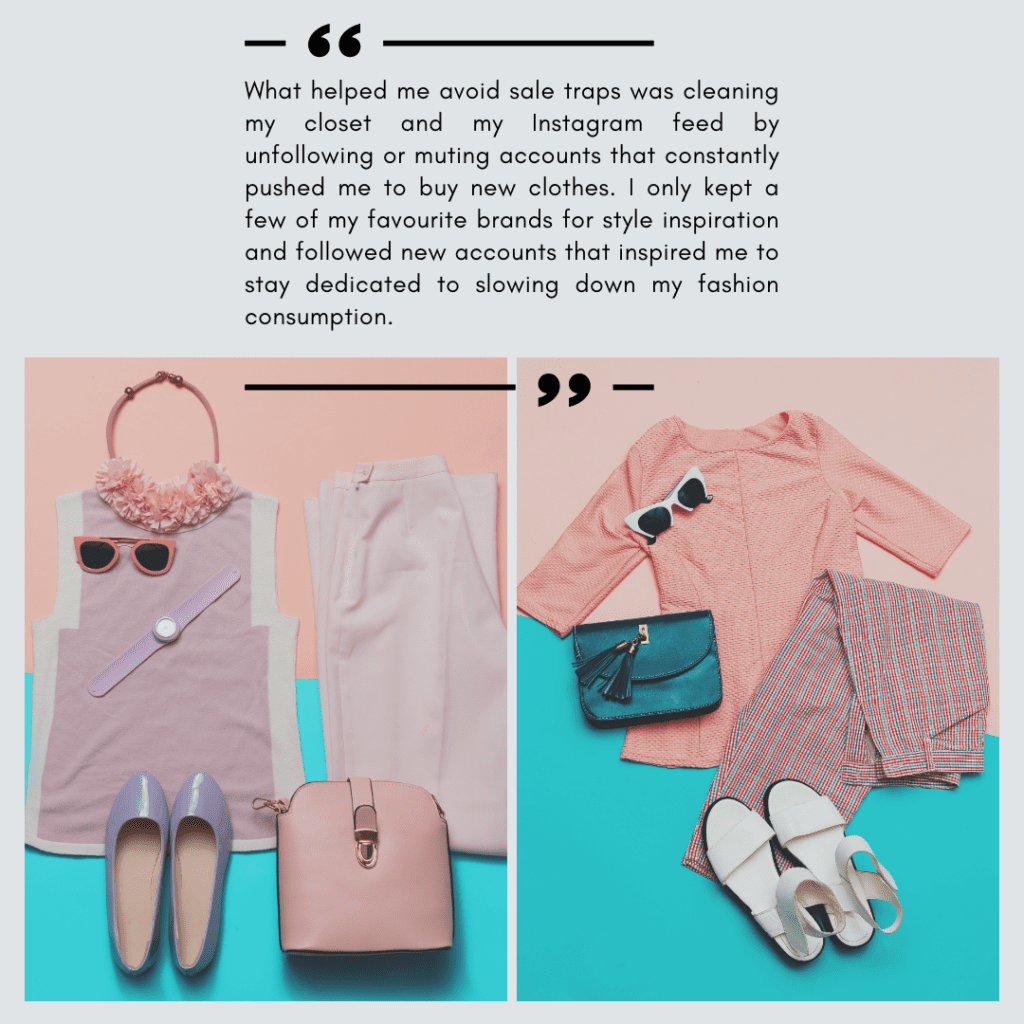Congratulations! You have made the first step by being here and questioning the way you consume fashion. This is already one big step in your journey, and you should be proud of yourself.
Now what? You might ask.
I’ve been there too. You realize that the way we shop, treat our clothes and the people who make them is not right, and you are probably wondering what YOU can do to change that.
Here are some of the things I have learned from my slow fashion journey to inspire you to start your own.
- You do not have to replace your whole closet with sustainable choices.
Avoid pressing the reset button on your wardrobe by throwing away everything that is not sustainable. I have heard many do this before: throw away all their “fast fashion” items and purchase only sustainable ones all at once. Unfortunately, this is everything but slow fashion, and it can get costly, very fast. You will quickly lose your motivation to keep going, especially as a young person on a budget.
Remember, the most sustainable piece of clothing is the one already in your closet.
- Take a journey in your closet to discover your style.
Before changing your shopping habits, take time to clean out your closet and reflect on the choices you have already made.
Think about which are your favourite pieces and why? What are your most worn combinations? Is there a pattern you can discover on how you choose your clothes?
With the answers to these questions, you can define your style and avoid making bad purchases in the future by simply asking yourself every time you buy something new – does this fit into your style, life, and closet?
- Avoid any sources of temptation.
Our feeds are full of sale ads and special offers from influencers, and one can only resist that much if we see them every day.
What helped me avoid sale traps was cleaning my closet and my Instagram feed by unfollowing or muting accounts that constantly pushed me to buy new clothes. I only kept a few of my favourite brands for style inspiration and followed new accounts that inspired me to stay dedicated to slowing down my fashion consumption.
You can even find daily challenges in slow fashion accounts like the ones from @myclothesmyworld – especially if you embark on your journey with a friend. This new change is something you can do together and track each other’s progress. I recommend it!
- Gather your facts on fast fashion.
What gave me even more motivation to keep going was discovering how fast fashion works. After watching my first documentary on its dark sides, I was determined to do everything I could to avoid overconsumption.
To find your purpose, as I did, do your research on fast fashion by watching documentaries such as The True Cost or River Blue or reading books or blogs on its consequences. You do not have to become an expert on this. It is enough to get some facts to help you understand why the slow fashion movement is relevant.
My personal favourite book is “Loved Clothes Last,” by Orsola de Castro, the co-founder of the Fashion Revolution movement. This is a candid and easy-to-understand guide on how to fall in love with our clothes and best take care of them. Orsola shares her own experiences, learnings and struggles with sustainable fashion, and instead of demonizing fast fashion, she teaches ways to buy less and cherish more and celebrate progress instead of perfection.
- Wear the clothes you own.
When you feel the need to buy something new, go shopping in your closet first.
Have you seen an amazing outfit in a magazine or on social media? Then, try to recreate it with items you already have in your wardrobe.
If you continually wear the same thing, dare to mix and match and don’t be afraid to repeat your favourite pieces in different combinations. For example, I always combine my favourite blazer with jeans for a casual look and a skirt or a dress for an elegant night out – 1 piece, two outfits and more.
Scarfs are also a great way to make your outfits more interesting without buying new outfits. You can wear one in at least five different ways, and you already have five different outfits.
- If you need a change in your closet, buy used or swap with your friends.
Slow fashion is not about restricting yourself; it can be a lot of fun.
You can try thrift shopping to diversify your wardrobe with unique pieces, or like I love to do a lot, invite your friends over for a swap party and find your new favourite pieces this way.
You can even go outside your friend’s circle and attend clothing swaps and flea markets in your community—one of the best ways to spend a Saturday morning if you ask me.
These are also great places to bring the clothes you no longer wear – you can either donate them to your favourite charity or second-hand shops and support their cause or bring them to the next clothing swap party you attend.
- Make clothes last, instead of jumping on trends.
If you decide to buy something new, then try buying less than what you need. Think of your closet more as a unique exhibition and concentrate more on curating than on filling.
Only invest in timeless pieces that fit into your wardrobe and are high in quality. If second-hand is not an option for you and you can only afford fast fashion right now, then only buy things you are sure you will wear at least 30 times. Then, try to picture them in your wardrobe, and if they do not fit, it’s better to let them go.
- What about repair & rewear?
Do not let a stain or a small hole be the end of your relationship with a favourite piece. Instead, learn easy ways to mend your clothes like our grandmothers did – you can get help from your family, learn these skills through tutorials online or even find repair cafes in your area, if available, where you can get support.
There is also always a nice, old-fashioned way of bringing your clothes to a tailor to repair and adjust your clothes. This is also a lovely way to support their craft and local businesses.
This is something I do a lot for shoes – I bring them to my local cobbler and have them fixed. This way, I can wear the vintage shoes I got from my mom for as long as possible.
- Expensive does not equate to fairness.
Another thing I learned along the way – if a piece costs a lot, it does not mean it is directly sustainable. Learn to understand how and where your favourite brands produce their clothes and hold them accountable if they are not transparent or appear to be greenwashing. You can do this by sending them a short message on social media or an email asking them who made their clothes or their production process. If you are going to invest in a piece from them, you might as well make sure it is as fair & sustainable as they say.
- Nobody’s perfect – better to be imperfectly sustainable than not at all.
Don’t give up and keep going, even if you could not help but go on a shopping spree last month with your friends or decided to do some retail therapy during hard times. As long as you are aware of your consumption and try your best to buy less and make your favourite items last, you are on the right track. If all of us do these small steps in the right direction – it is way better than if none of us tried to at all.
Do not be afraid to take it slow. Nobody expects you to slow down fast.

